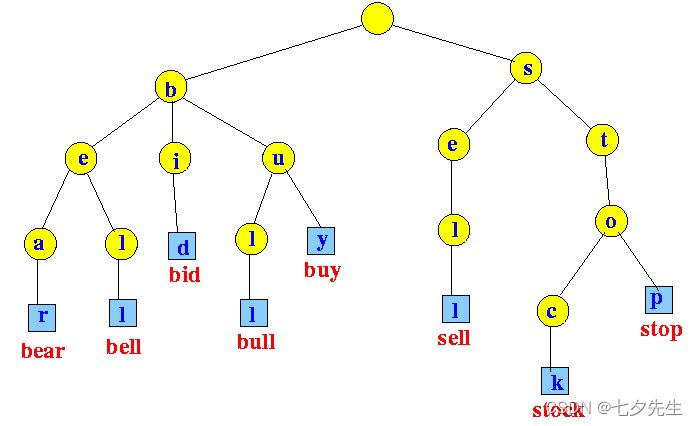大厂面试必考——字典树(前缀树)及其C++实现
字典树
字典树(trie)也称为前缀树,它其实是一种k叉树。一般用来在一组字符串中快速定位某个字符串,如下图中,可以在["bear", "bell", "bid", "bull", "buy", "sell", "stock", "stop"]这一组字符串中快速定位其中一个字符串,时间复杂度只需要
O
(
l
)
O(l)
O(l),其中
l
l
l是指定位字符串的长度,相比于遍历小了很多。

当然,字典树除了字符串这种典型应用,也可以应用于其他情况。
字典树这种数据结构,在大厂面试中经常被考到。比如在leetcode 208. 实现 Trie (前缀树)的评论区中就有不少人分享经验:


字典树的C++实现
字典树的实现也不算困难,关键是插入和查找两个接口。
class Trie {
private:
vector<Trie*> children;
bool isEnd;
Trie* searchPrefix(string prefix) {
Trie* p = this;
for(char c : prefix) {
int idx = c - 'a';
if(p->children[idx] == nullptr) {
return nullptr;
}
p = p->children[idx];
}
return p;
}
public:
// 初始化
Trie():isEnd(false) {
this->children = vector<Trie*> (26, nullptr);
}
// 析构函数
~Trie() {
for(int i = 0;i < 26;++i) {
if(this->children[i] != nullptr) {
delete this->children[i];
}
}
}
// 插入接口
void insert(string word) {
Trie* p = this;
for(char c : word) {
int idx = c - 'a';
if(p->children[idx] == nullptr) {
p->children[idx] = new Trie();
}
p = p->children[idx];
}
p->isEnd = true;
}
// 查找接口
bool search(string word) {
Trie* resNode = searchPrefix(word);
return resNode && resNode->isEnd;
}
bool startsWith(string prefix) {
return searchPrefix(prefix) != nullptr;
}
};
关于内存管理
需要注意的是,用C++实现时会涉及到内存管理的问题,也经常被考查到,比如208题目的评论区中就有这样的分享:

那么什么时候需要主动释放内存呢?
我们知道,在程序运行时动态分配的内存是存储在堆中的,需要我们手动管理。
简单概括的话,就是手动分配的内存要手动释放,否则容易造成内存泄露。
以vector为例,如果不是通过new方式创建的,vector本身的实现会负责内存的创建和释放;而如果是使用new方式创建的vector,就需要手动通过delete删除。通过malloc分配的内存也需要通过free释放。
所以,在我们上面的实现中,需要手动释放通过new分配的内存。
字典树相关题目
除了直接的字典树实现题目208. 实现 Trie (前缀树),
2707. 字符串中的额外字符、1803. 统计异或值在范围内的数对有多少和472. 连接词也与字典树相关。
本文来自互联网用户投稿,该文观点仅代表作者本人,不代表本站立场。本站仅提供信息存储空间服务,不拥有所有权,不承担相关法律责任。 如若内容造成侵权/违法违规/事实不符,请联系我的编程经验分享网邮箱:chenni525@qq.com进行投诉反馈,一经查实,立即删除!
- Python教程
- 深入理解 MySQL 中的 HAVING 关键字和聚合函数
- Qt之QChar编码(1)
- MyBatis入门基础篇
- 用Python脚本实现FFmpeg批量转换
- 100个GEO基因表达芯片或转录组数据处理之GSE27342(007)
- 搜索引擎优化指南:SEO关键字、长尾关键字、短尾关键字以及反向链接
- 全面了解网络性能监测:从哪些方面进行监测?
- 【adb】--- win10 配置 adb环境 超详细 (持续更新中)
- 系统编程—进程
- 用java以数组为底层结构创建循环队列
- CCF-B类 | 持续中科院1区TOP,Elsevier出版社,50年老刊!
- 【星海记录】文献记录
- 物联网与智慧城市的无界未来:如何打破传统束缚,开启智能生活新篇章
- 最好用的Mybatis插件:IDEA中MyBatisCodeHelperPro插件下载安装(全版本)、MyBatisCodeHelperPro插件激活方法、支持Windows/Mac系统(保姆级教程)